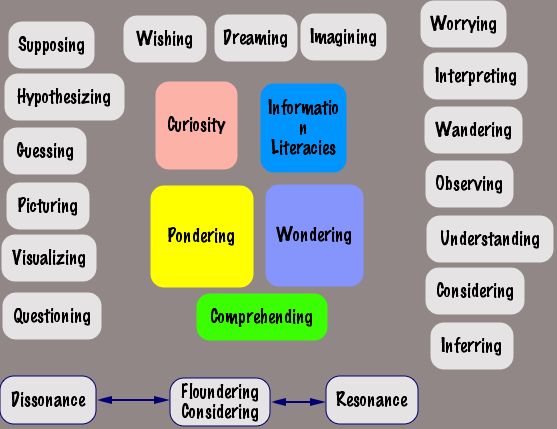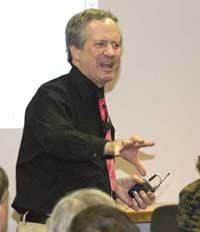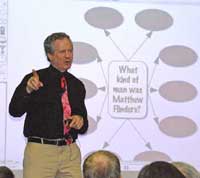8:30 AM - 9:00 AM
Registration and Coffee
9:00 AM - 10:30 PM
Powerful Writing, Thinking and Reading
Learn how to equip students with the skills to make and communicate meaning even when the tasks are challenging and the answers are elusive, mysterious or puzzling. Jamie shows how new technologies can empower students to wrestle with difficult material and make up their own minds. He will illustrate the intersection between the composition of ideas, visual thinking, synthesis, comprehension and the invention of meaning. Central to the effort is grasping the relationships and interactions between wondering, pondering, comprehending and the other concepts in the diagram below:

10:30 AM - 10:45 AM
Coffee Break
10:45 AM - Noon
Authentic and Engaged Learning
Learn how to employ the best elements of these two learning models so your students are challenged to wrestle with difficult questions while intrigued by the issues being explored.
Across the land, teachers are under increased pressure to meet challenging objectives set by state curriculum standards. To meet these thinking, problem-solving and communicating standards, it pays to involve students in seeing how these skills are practiced in the world of work outside of school. As much as possible, it makes sense to involve them in such work, either through internships, visits, interviews or simulations.
Even though some of these activities may be staged or simulated, they still pass the test of authenticity because they meet the following criteria:
- They are rooted in issues, challenges or decisions that people face in the world.
- They are genuine.
- The act of wrestling with these challenges is purposive - saturated with meaning and significance.
- A student can see a payoff in the future for work well done and skills acquired
12:45 PM - 3:00 PM
Wondering with and about Images, Words and Numbers
Central to understanding the new information landscape is the application of inferential reasoning skills to the challenge of interpretation. Jamie leads the group through a series of such challenges from a wide range of media and shows how these tasks can be used to strengthen the comprehensions skills of students.
Images
Paintings, photographs, sketches and other types of images can provoke a sense of wonder and engage students in valuable inferential reasoning as they seek to grasp explicit and implicit meanings. Jamie will lead the group through a series of examples ranging from propaganda posters of previous wars through paintings and current advertising. "What's the story here?" will recur as a persistent question driving interpretation.
Numbers
Research findings, climate data, economic data and other types of data collections are much like other information sources, as they can provoke a sense of wonder and engage students in valuable inferential reasoning as they seek to grasp explicit and implicit meanings. Jamie will lead the group through a series of examples ranging from recent reports of educational research through datasets for population, crime and climate as well as news articles claiming to report the meaning of such data. As with pictures, "What's the story here?" will recur as a persistent question driving interpretation of the numbers.
Words
Many passages offer much more than surface meaning, providing levels of metaphor or subtexts that may be more important than what first meets the eye. In some cases, these levels are poetic in their intention. In other cases, words are used to control, influence and persuade. Jamie will lead the group through a series of examples ranging from poetry to news reports, editorials, advertisements and policy documents, showing how students can learn to wonder, ponder and unwrap such documents. As with pictures and numbers, "What's the real story here?" will recur as a persistent question driving interpretation of the text.
|


